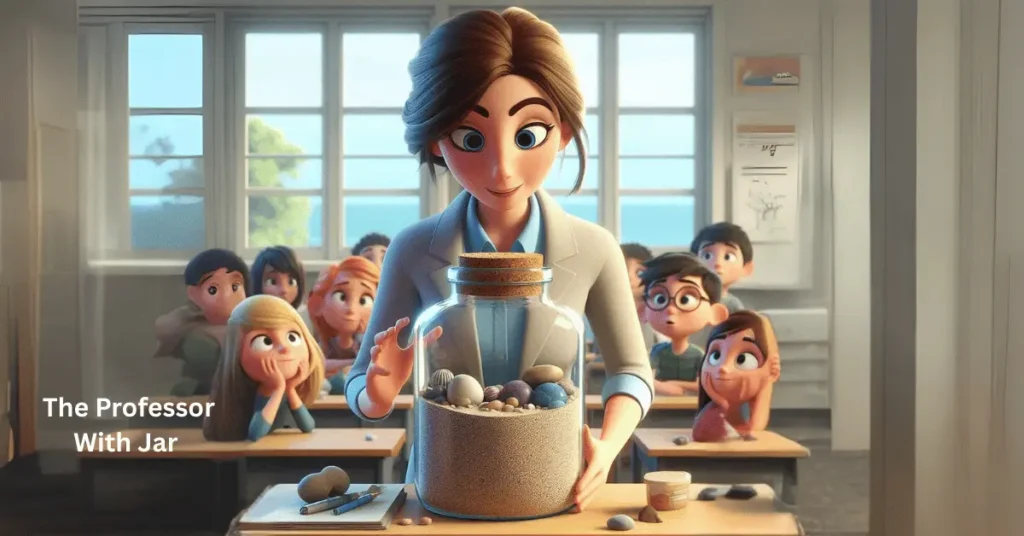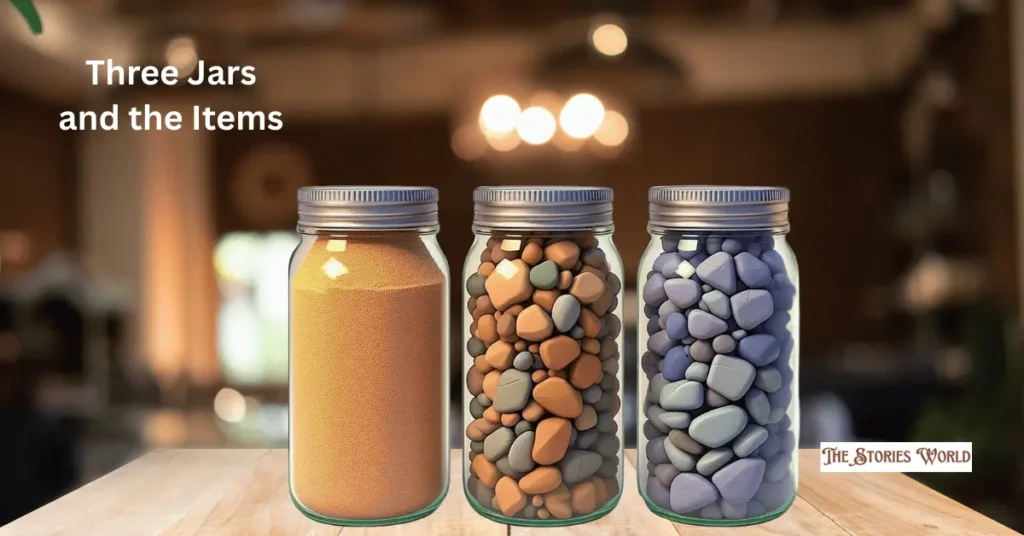Rock Pebbles and Sand Story with Moral lesson for Students
Updated: 03 May, 2025
123
“Rock Pebbles and Sand Story with Moral lesson for Students” is a powerful tale about time management and prioritisation.
It uses impactful yet straightforward metaphors to show how focusing on your big priorities, like health, family, and goals, can help you live a balanced and fulfilling life.
The story teaches valuable lessons on productivity, decision-making, and personal growth, reminding kids and adults alike to prioritise what matters and not get lost in minor distractions.
It is a must-read for anyone looking to improve their life balance and make smarter choices!
Short and Simple History of the Story
The “Rock, Pebbles, and Sand” story isn’t ancient, but it’s become one of the most loved and shared stories regarding teaching life lessons.
No one knows exactly who created it, but over the years, many teachers, motivational speakers, and authors have used this story to explain one powerful idea:
If you focus on what truly matters first, everything else will fall into place.
One well-known author, Stephen Covey, who wrote “The 7 Habits of Highly Effective People,” shared a similar version of this story to teach people how to manage their time wisely and prioritise the most important things.
The story is now told in schools, seminars, workshops, and even at home—because it works for everyone, from kids to adults!
Why is it so popular?
Because it uses simple objects (like rocks, pebbles, and sand) to explain a very big life lesson—one that can help you live a more balanced, happy, and focused life.
Rock, Pebbles, and Sand Moral Story for Kids – Let’s Read

It was a bright Monday morning, and the employees of a growing tech startup gathered in the conference room for their weekly leadership session.
At the front of the room stood Maya, a productivity coach known for her unique and thought-provoking presentations.
On the table before her were some unusual items: a large transparent glass jar, a tray of big smooth rocks, a bowl of pebbles, a container of fine sand, and a bottle of water.
Curious murmurs filled the room. Maya smiled and said,
“Today, I’m not just going to tell you something—you’ll see it.”
More Moral Stories
The Jar and the Items
Maya approached the table and gently picked up a large, clear glass jar. It was empty, clean, and big enough to hold quite a few things.
She held it up and said,
“Let’s imagine this jar is your life. Your day. Your week. Whatever you want it to be. But just like this jar, your time and energy have limits.”
Then, she pointed to the items laid out in front of her:
- A tray of big, solid rocks – smooth, heavy, and a bit uneven in shape.
- A bowl of small pebbles – light grey and round, they looked neat and organised.
- A container full of fine sand – soft, grainy, and constantly shifting.
And to the side, a bottle of water, which she hadn’t mentioned yet.
She continued, “Each represents different parts of your life. The big rocks? These are your top priorities. The things that matter—like your health, family, dreams, and peace of mind.”
“The pebbles? They’re still important—but not as important. Maybe your job, car, hobbies, social media accounts.”
“And the sand? That’s the little stuff. Scrolling through your phone for hours, unnecessary errands, gossip, and things that don’t move your life forward.”
People in the room started nodding slowly. The message was already beginning to hit home.
“Now,” she said gently, “let’s try to fit it all in. But here’s the catch—we’ve got to do it the right way.”
Filling the Jar with Big Rocks

Maya picked up the big rocks and gently placed them into the empty jar.
Everyone in the room watched closely.
She said,
“These big rocks are the most important parts of your life. Think about things like your health, family, close friendships, goals, and peace of mind—things that matter in the long run.”
As she added each rock, the jar slowly started to fill up. After a few stones, the jar looked quite full already.
She smiled and asked the group,
“Okay, is the jar full?”
Some people nodded, others looked unsure.
“Well,” Maya said, “let’s find out.”
Adding the Pebbles
Maya reached for the bowl of small pebbles and slowly started pouring them into the jar.
As the pebbles fell in, they slipped into the little gaps between the big rocks, and the jar began to look even fuller.
“These pebbles,” Maya explained, “represent other important parts of your life—but not as important as the big rocks.”
She paused and gave a few examples:
“Your job, your car, your house, your weekend plans, your hobbies—these are all pebbles. They still matter, but your life wouldn’t completely fall apart without them.”
The room was quiet. People were starting to reflect.
Once all the pebbles were in, she shook the jar gently. The pebbles settled in snugly between the rocks.
“Now,” she grinned, “is it full?”
This time, a few people laughed and said, “Maybe?”
She winked and said, “Let’s keep going.”
Pouring in the Sand
Maya then picked up the container of sand and began to pour it into the jar.
As the sand started to fall, it filled in all the tiny spaces between the big rocks and pebbles. It trickled into every little gap, making the jar look almost full.
She smiled and said,
“This sand represents all the small stuff in life—the things that feel urgent, but really don’t have much lasting impact.”
“Things like checking your phone constantly, getting distracted by social media, running errands that don’t matter, or worrying about things that might never even happen.”
The sand filled the jar quickly, leaving barely any space. The room was quiet, and everyone was watching closely.
“Now,” Maya said, “Is the jar full?”
A few people hesitated but nodded, thinking it’s full now.
Maya nodded and said, “Okay, let’s look closer.”
The Big Surprise – Adding Water
Maya reached for the water bottle and slowly began to pour it into the jar.
To everyone’s surprise, the water filled the remaining tiny spaces—the little cracks and corners. Even though the jar seemed packed with rocks, pebbles, and sand, there was still room for the water.
“Now,” Maya said with a playful smile, “you might be wondering what the water represents.”
She paused for a moment, letting everyone think.
“The water,” she continued, “is like all those little interruptions and unplanned moments in life—unexpected phone calls, random thoughts, distractions, and anything that doesn’t contribute to your big goals or priorities.”
She looked around the room and added,
“The jar can still hold the water, but only because we first put the big rocks and pebbles in. If we’d started with the sand or the water, there wouldn’t have been room for the things that truly matter.”
Everyone in the room was nodding now. The lesson was clear.
Moral of the Story – What Really Matters?
Maya looked around at the group, making sure everyone was following along.
She said, “Here’s the story’s point: If we start by focusing on the big rocks, the things that matter most—like your health, relationships, and personal growth—then we’ll have plenty of space for the pebbles and sand.”
“But,” she continued, “if you fill your jar with sand first—those small distractions—then the big rocks, the things that really matter, won’t have room to fit in.”
A few people were nodding, clearly understanding the more profound message.
“So ask yourself,” Maya said, “What are your big rocks? What are the things that you absolutely cannot live without? Are you giving them the attention they deserve?”
She paused for a moment before adding,
“If you fill your life with the most important things first, everything else will find its place.”
Everyone sat back in thought, realising how often they’d focused on the little things, the sand, and not their big rocks.
“Remember,” Maya smiled, “it’s not about how full your jar looks—it’s about what you choose to put in it. Make room for your big rocks, and the rest will follow.”
What Kids Can Learn from This Story
- Prioritise What Matters Most: The story teaches kids that the most essential things in life—like family, health, and schoolwork—should come first. If they focus on their big “rocks” first, they’ll always have room for everything else.
- Don’t Let Small Distractions Take Over: The sand in the jar represents all the little things that can distract us, like too much screen time or small, unimportant tasks. If kids focus on these too much, they won’t have time for their bigger, more important goals.
- Manage Your Time Wisely: By making time for their big rocks first, kids can learn to manage their time better and ensure they’re not wasting it on things that don’t help them grow or achieve their dreams.
- Balance is Key: The story also shows that balance can be found. Life has to include both big and small things, but the big things should always come first. Once the important stuff is done, there’s space for the smaller, fun stuff, too!
- Be Aware of Your Choices: Kids will also learn that they have control over how they spend their time and what they focus on. It’s all about making good choices and filling their “jar” with the things that will help them lead happy, successful lives.
Follow-Up Questions For This Story
| Follow Up Questions |
|---|
|
Please Write Your Comments